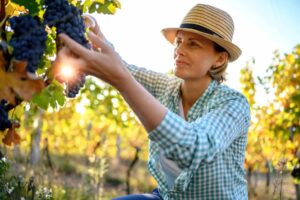How did Anteprima Sagrantino 2019 go?
Also this year the event was very followed by the Italian and international press and by those working in the wine sector.
In this 2023 edition, in fact, over 150 journalists from all over the world came to our Montefalco and took part in the two days of tastings, visits to the cellar, conferences and events dedicated to the main wine of our territories: the Sagrantino di Montefalco vintage 2019.
But not only Sagrantino was discussed in this edition, many other typical and native wines have found space to make themselves known to an audience of great experts (we talked about them in our previous article here).
A 5 stars vintage for the Sagrantino 2019
The Commission in charge defined the wines proposed by the 40 farms in the Umbrian territory during the event of 19 and 20 April 2023 as a 5-star vintage and 95/100.
A huge success for all the participants, including us, who can find all their commitment in a unanimous judgment obtained by professionals of great depth.
The total number of wines for tasting was 153 plus 27 Sagrantino Docg 2019 and 3 Passito Docg 2019.
Compared to last year, about half of the Sagrantino di Montefalco wines were presented to leave space only for wines with a minimum of bottle aging, ready to face a high-level tasting.
The report of Anteprima Sagrantino 2019 for Azienda Agricola Montioni
Are you curious to know what was the opinion of Montioni wines during Anteprima Sagrantino 2019?
Here are some of the reviews and ratings obtained.
Montefalco Sagrantino Passito Montioni 2019
“Hints of blackberry jam and cherries in alcohol, light scent of lavender, round and clean to the taste. Too bad only 1000 bottles.”
Diana Niglio – Luciano Pignataro wine&food blog
Maurizio Valeriani and Gianni Travaglini of “Vino da bere” also select our Passito from among the best presented in the competition.
Montefalco Sagrantino Montioni
Among the best Sagrantinos tasted, Maurizio Valeriani and Gianni Travaglini of “Vino da bere” also choose ours.
“It smells of leather and blackberries, vanilla and coffee, the prelude to a precise, soft and very persistent sip.”



7) A cottura ultimata, rompere la crosta con un martelletto da cucina e ripulire il pesce dal sale in eccesso.

8) Ottenere le porzioni, aggiungere un filo di Olio extra vergine di oliva Montioni per rendere il pesce ancor più morbido e saporito.
Servire accompagnando il piatto con un ottimo Umbria Grechetto I.G.T. Montioni, perfetto con il pesce, ad una temperatura consigliata tra i 10°C e i 12°C

Dopo un filo d’Olio extravergine Montioni, il pesce al sale è pronto per essere gustato, accompagnato da un buon bicchiere di Grechetto della cantina Montioni!
Buon appetito!
Ringraziamo Paolo da Bologna per la gustosa ricetta e l’abbinamento perfetto da lui creato Tra Cucina e Cantina!
Aspettiamo con curiosità tutti vostri golosi abbinamenti! Potete rileggere tutte le regole per inviarci le vostre ricette qui!
On occasion, the winemaker may decide to leave them in if the grapes themselves contain less tannin than desired. This is more acceptable if the stems have ‘ripened’ and started to turn brown. If increased skin extraction is desired, a winemaker might choose to crush the grapes after destemming.
Wine is one of the most civilized things in the world and one of the most natural things of the world that has been brought to the greatest perfection, and it offers a greater range for enjoyment and appreciation than, possibly, any other purely sensory thing.
Ernest Hemingway Tweet
Removal of stems first means no stem tannin can be extracted. In these cases the grapes pass between two rollers which squeeze the grapes enough to separate the skin and pulp, but not so much as to cause excessive shearing or tearing of the skin tissues. In some cases, notably with “delicate” red varietals such as Pinot noir or Syrah, all or part of the grapes might be left uncrushed (called “whole berry”) to encourage the retention of fruity aromas through partial carbonic maceration.
The Grapes
The quality of the grapes determines the quality of the wine more than any other factor. Grape quality is affected by variety as well as weather during the growing season, soil minerals and acidity, time of harvest, and pruning method. The combination of these effects is often referred to as the grape’s terroir.
Grapes are usually harvested from the vineyard from early September until early November in the northern hemisphere, and mid February until early March in the southern hemisphere.
In some cool areas in the southern hemisphere, for example Tasmania, harvesting extends into May. The most common species of wine grape is Vitis Vinifera, which includes nearly all varieties of European origin. The most common species of wine grape is Vitis Vinifera, which includes nearly all varieties of European origin.

Manual harvesting is the hand-picking of grape clusters from the grapevines. In the United States, some grapes are picked into one- or two-ton bins for transport back to the winery. Manual harvesting has the advantage of using knowledgeable labor to not only pick the ripe clusters but also to leave behind the clusters that are not ripe or contain bunch rot or other defects. This can be an effective first line of defense to prevent inferior quality fruit from contaminating a lot or tank of wine.
Destemming is the process of separating stems from the grapes. Depending on the winemaking procedure, this process may be undertaken before crushing with the purpose of lowering the development of tannins and vegetal flavors in the resulting wine. Single berry harvesting, as is done with some German Trockenbeerenauslese, avoids this step altogether with the grapes being individually selected.
Crushing is the process when gently squeezing the berries and breaking the skins to start to liberate the contents of the berries. Destemming is the process of removing the grapes from the rachis (the stem which holds the grapes).
In traditional and smaller-scale wine making, the harvested grapes are sometimes crushed by trampling them barefoot or by the use of inexpensive small scale crushers. These can also destem at the same time. However, in larger wineries, a mechanical crusher/destemmer is used. The decision about destemming is different for red and white wine making. Generally when making white wine the fruit is only crushed, the stems are then placed in the press with the berries. The presence of stems in the mix facilitates pressing by allowing juice to flow past flattened skins.

Katerina Monroe
@katerinam • More Posts by Katerina
Congratulations on the award, it's well deserved! You guys definitely know what you're doing. Looking forward to my next visit to the winery!
